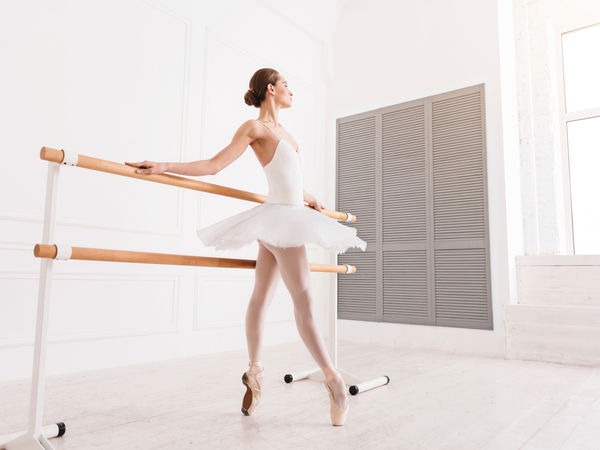The Centers for Advanced Orthopaedics is redefining the way musculoskeletal care is delivered across the region with locations throughout Maryland, DC, Virginia and Pennsylvania.
Tips for Preventing Ballet Injuries from a Foot & Ankle Surgeon

Article by Megan Staub via Falls Church Patch
May 16th, 2017
Stretching and strengthening the calf and ankle on a daily basis are key to preventing overuse injuries in the dancers.
By Daniel Cuttica, D.O., The Centers for Advanced Orthopaedics
If you have watched a professional ballet performance, you likely noticed the dancers’ grace and fluidity of motion, and the ease with which they execute complicated lifts, jumps and spins. But you may not have recognized the strength, training and endurance that is the hallmark of elite athletes from the NFL to the Olympics.
The artistry of dance can be misleading. As a physician and consultant for The Washington Ballet, I know that their seemingly effortless performances conceal one of the most physically demanding sports. In fact, one study published in The Journal of Sports Medicine compared 61 sports and determined ballet to be the most challenging physical activity – ahead of both bullfighting and football.
And as with any elite sport, it should be no surprise that injuries are common. Research studies show that 67% to 95% of professional ballet dancers are injured each year. This is why dance medicine is a unique and important niche within the sports medicine orthopaedic specialty.
What is dance medicine?
A dance medicine specialist understands and treats the acute and chronic injuries that are specific to dancers. We are familiar with the precise postures, weight placement and repetitive movements that are required in the sport and can contribute to injury. We work very closely with the dancers, physical therapists and trainers to care for injuries and oversee measures for preventative care.
For example, many dancers have tight calf muscles and Achilles tendons because they spend so much time on their toes in the en pointe or relevé positions. This can lead to a variety of other injuries, because a tight calf muscle will put more stress and strain on the forefoot or midfoot area while dancing, possibly resulting in stress fractures or tendonitis.
Because of this, we work with ballet dancers to incorporate some basic rehab exercises and specific ankle and calf stretches into their daily warmup routines.
Common Injuries
An important understanding of the dancer’s physical demands and techniques is essential in both the treatment and prevention of dance injuries. The majority of a dancer’s injuries occur in the lower extremity, especially the foot and ankle. Most injuries are classified as “overuse” injuries, due to repetitive movements that put increasing stress on a joint, muscle or tendon. However, acute injuries can occur as well.
The most common “acute” – or unexpected – injury seen in all levels of dancers is an ankle sprain. This occurs when a dancer accidentally rolls their ankle inwards or outwards, often after landing a jump incorrectly. Because an ankle sprain damages ligaments on the inside or outside of the ankle, dancers with this injury can be more susceptible to ankle injuries in the future. Adequate physical therapy and rehabilitation are necessary to restore normal use and function of the ankle after the injury. In addition, preventative measures, such as specific stretching and strengthening exercises, are critical to build additional strength and support for the ankle and protect against both acute and overuse injuries.
Tips for Young Dancers
Elite dancers have been trained for years in proper ballet technique, and they are very aware of their bodies and how to best warm up for class or performance. Unfortunately, younger dancers don’t have the same level of experience and technique, and that often leads to injury.
Research studies show that dancers ages 12-18 are the most likely to get injured. This could be due to a number of reasons, from practicing incorrect technique to skipping warm-ups, wearing too-tight shoes, an increasingly intensive training schedule or growth spurts that make it difficult to maintain technique.
The most important thing that young dancers can do to prevent injury is to listen to their body and resist the temptation to dance through even minor pain. These pains could turn into more serious injuries if they are not quickly or properly addressed, such as stress fracture or tendon injury. Other ways to prevent injury include paying close attention to correct technique, wearing properly fitting shoes, and ensuring a proper warm-up and cool-down.
I also recommend that parents and teachers emphasize the value of stretching and strengthening exercises in class, and that younger dancers regularly practice strengthening exercises for key joints such as the ankles, knees and hips. Consistently stretching the ankles and calves is a critical way to protect against tight tendons and the variety of injuries that can result. Cross-training is also helpful to provide further support to the muscles and tendons that are regularly used in ballet.
Ballet may look graceful and effortless, but it is a demanding sport that requires an incredible amount of strength, flexibility and endurance from its athletes. To best prevent injury, dancers at any level should listen to their bodies, execute specific strengthening exercises and work closely with their teachers, trainers, and physicians if they experience pain while dancing.
Daniel Cuttica, D.O., is a board-certified orthopaedic surgeon specializing in foot and ankle surgery at The Orthopaedic Foot & Ankle care center in Falls Church, VA. Dr. Cuttica has expertise in both common and complex disorders of the foot and ankle, including cartilage disorders and restoration, total ankle replacement, arthroscopy and minimally-invasive procedures and forefoot reconstruction. He serves as an orthopaedic consultant for The Washington Ballet, has authored numerous publications in peer-reviewed journals and is a reviewer for the peer-reviewed journals Foot and Ankle International and Foot and Ankle Specialist.